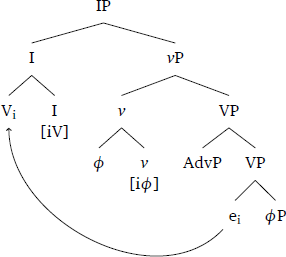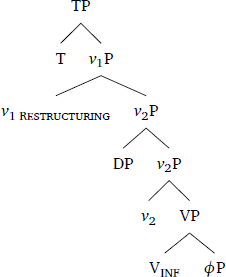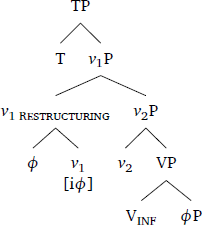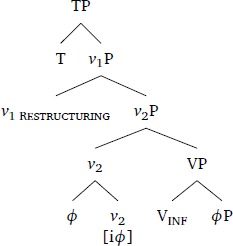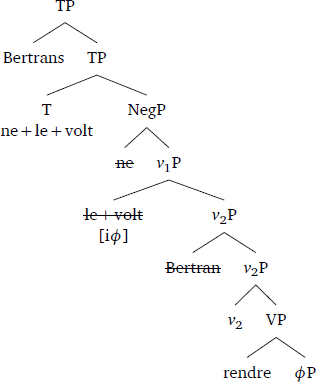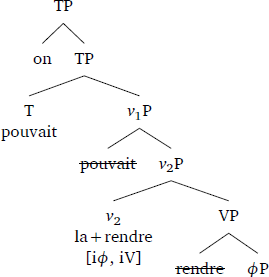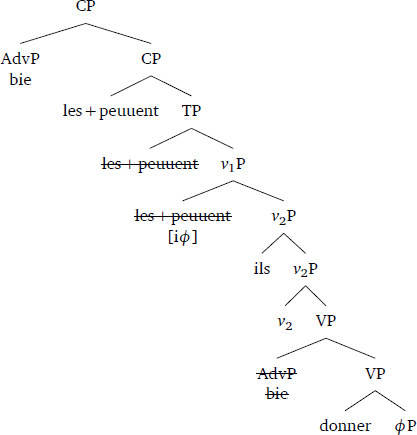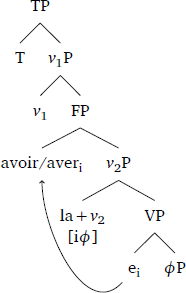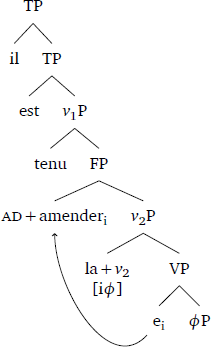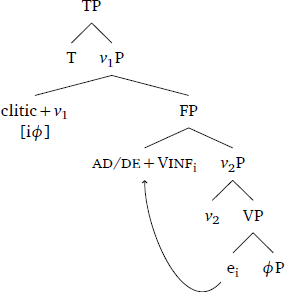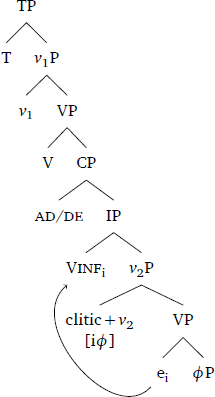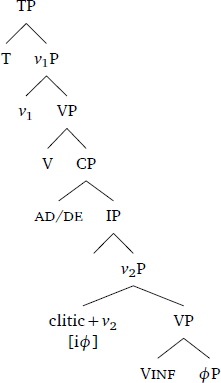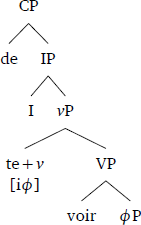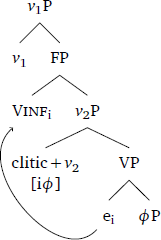1 Introduction
Clitic climbing (CC henceforth) is a syntactic process in which a clitic, which is typically associated with an embedded infinitive (e.g. an object, a locative, or an unselected dative), is instead attached to a verb in the main clause. CC is found in most modern Romance languages (Catalan, Francoprovençal, Italian, Occitan, Sardinian, Spanish, European Portuguese),1 where it is generally optional (that is, the clitic may attach to either the lower verb, or the higher verb). Earlier French is known to have exhibited this phenomenon extensively (1).
- (1)
- Old French (Corpus Philippicum, J 1034, n54. Late 13th c.)2
- il
- he
- le pouet
- 3sg=can
- faire
- do-inf
- ‘he can do it’
In this context, CC is traditionally analysed as a result of restructuring, a process that unites two clauses and yields a monoclausal environment (Rizzi 1982). Restructuring is also famously related to other syntactic phenomena, commonly referred to as transparency effects, notably auxiliary switch (2) and se-passives (3) (Rizzi 1982; Pearce 1990; Roberts 1997; Cinque 2004; Wurmbrand 2001; 2004), which are found cross-linguistically in languages that have CC.3
- (2)
- Old French (Pearce 1990: 20)
- Vous
- you
- estes
- are
- volue
- wanted
- apparoir
- appear-inf
- ‘You wanted to appear’
- (3)
- Old French (Pearce 1990: 18)
- car
- for
- amors
- love.nom
- ne
- neg
- se puet
- refl=can
- celer
- hide-inf
- ‘for love cannot be hidden’
The constructions exemplified in (1) but also (2) and (3) are not available in Modern French (although see example (53) in section 10), and this in turn has been a strong motivation to the claim that this language does not have restructuring anymore (Roberts 1997; Authier & Reed 2008). The aim of this article is twofold: first, we show when and why French lost CC, and secondly, we provide a formal analysis of restructuring, within the view that clitics are heads probed by features on v (Mavrogiorgos 2010; Roberts 2010), and that restructuring in Old French is monoclausal (Cinque 2004).
The presence of CC in the diachrony of French is not a novel observation (Foulet 1919; de Kok 1985; Martineau 1990), yet there has been a renewed interest for this phenomenon in the literature (Iglesias 2015; Amatuzzi et al. 2020; Bekowies & McLaughlin 2020; Olivier 2022a). In contrast to these studies which are either philological, or focus on short segments of diachrony, we provide a novel account of (the evolution of) both restructuring and CC based on a dataset covering seven centuries (12th–19th). We propose an analysis of language change that explains why French transitioned into a system where the clitic is systematically proclitic on the infinitive, despite prior variation in order. Specifically, we adopt Roberts’ (2010) analysis of CC (as Agree with v) which we apply to a new data set, and we show that the distinction between phonological cliticisation and syntactic cliticisation, as put forward by Ledgeway & Lombardi (2005), is crucial to understand the change the language undergoes. Specifically we argue that whilst Roberts’ (2010) hypothesis can account for several synchronic stages, there is further evidence that two mechanisms of cliticisation exist and are crucial to account for the diachronic changes observed in French. Indeed, we also show that it accounts for the fact that enclisis and CC are typically found together, as they derive from the availability of phonological cliticisation within one grammar.
The paper is organised as follows: in section 2 we present the novel corpus that we specifically created for this study, where the findings are given quantitatively and diachronically. We present our formal assumptions of restructuring, CC and cliticisation in section 3. The main shifts identified in the corpus are presented and discussed in section 4, where we divide French into three diachronic stages. In section 5 we introduce evidence of the monoclausality of restructuring in showing that the co-occurrence of infinitive-movement and enclisis in Old French diagnoses the presence of an embedded v-head – this section introduces further evidence for the functional nature of restructuring verbs, which we identify with the lack of interpolation and movement in V2 clauses. The presence of non-finite complementizers and Wh-items in sentences with CC is discussed in section 6, and in section 7 we present an analysis that accounts for the loss of CC. The implications of our analysis on other Romance languages are discussed in section 8; we propose that the presence of infinitival enclisis in a language can contribute to the presence of CC. We extend the discussion to pro-drop in section 9, and we argue that the loss of null-subjects has had no causal relationship with the loss of CC in French. We conclude that, although CC is not available in Modern French, restructuring is still present, and we draw further generalisations with regards to the locus of language change.
2 Corpus
Our contribution draws empirical data from a corpus of texts that have never been explored with respect to clitic placement.4 In the following subsections, we first contextualise the corpus, before presenting a bird’s eye view of the data.
2.1 Methodological choices
For this study, we constructed a corpus of prose texts, specifically legal material. In the last decade or so a number of historical linguists have considered registers that are less traditional, the syntax of which had not been investigated before (Le Feuvre 2008; Diez Del Corral Areta 2011; Stolk 2015; Balon & Larrivée 2016; Kytö 2019; Olivier 2021). One important benefit of selecting non-literary texts is that a change that takes place in the language is likely to be reflected earlier on. This prediction is borne out in Balon & Larrivée’s (2016) study of the loss of pro-drop in French. Whilst the literature on the topic is traditionally concerned with literary texts and generally situates the transition of French into a non-null subject language around the 15th or 16th century (Adams 1987; Hirschbühler 1995; Roberts 2014), the corpus built by Balon & Larrivée (2016) is exclusively composed of legal material and does not provide evidence of pro-drop after the 13th century. Wolfe (2020) argues that there is a major discrepancy between the two text types, and that the parameter was retained in the standardised written language long after it was effectively lost from the oral language.
From the 12th century on, French infiltrates official documents that were otherwise written in Latin. Normandy is one of the first regions where Old French is recorded in the law, notably with the Lois de Guillaume which were composed in 1150. In 1534, Guillaume Le Rouillé wrote Le Grant Coustumier du pays et duché de Normendie in French, a choice he explicitly justified: “Lequel eſt le texte diceluy en francoys proportiōne a lequipollent de la gloſe ordinaire et familiaire”, ‘the aforementioned text is in French, proportional to the equivalence of the ordinary and familiar language’ (our translation). Given the assumption that the law must be intelligible by all, Le Rouillé claims to use a language more ‘ordinary’ and ‘familiar’. As pointed out by an anonymous reviewer, although this may not hold true for the lexicon, we may expect the grammar of legal writing to be less remote from the vernacular than literature.5
2.2 Database of the study
We selected and manually tagged a comprehensive selection of historical legal French texts (with one exception discussed below) to reveal the full diachrony of CC: our corpus contains 19 texts that cover a period of more than 700 years, from 1150 to 1856 (Table 1). This time span aims at casting a wide net to collect data from the earliest texts available until shortly after the definite loss of CC in order to reveal the full evolution of the phenomenon.
Corpus.
| Source | Period | Words | Clitics | |
| Old French | Lois de Guillaume | 1150 | 3,250 | 18 |
| Brut | 1155 | 15,637 | 55 | |
| SCRIPTA 1 | 1154–1189 | 2,580 | 8 | |
| SCRIPTA 2 | 1208–1265 | 2,669 | 7 | |
| Établissements Coutumes | 1207–1270 | 23,718 | 101 | |
| Actes de Ferri III | 1251–1303 | 166,807 | 349 | |
| Corpus Philippicum | 1272–1299 | 29,026 | 53 | |
| SCRIPTA 3 | 1277–1294 | 15,228 | 24 | |
| Grand Coutumier | 1300 | 60,507 | 427 | |
| Middle French | Actes Royaux du Poitou | 1302–1341 | 31,530 | 108 |
| Mortemer | 1320–1321 | 11,530 | 15 | |
| Actes Normands | 1328–1350 | 5,464 | 17 | |
| Lettres de rémission | 1357–1360 | 19,901 | 80 | |
| Actes de la Chancellerie | 1422–1435 | 63,978 | 269 | |
| Rouillé | 1539 | 54,599 | 289 | |
| Terrien | 1578 | 57,067 | 270 | |
| Bérault | 1614 | 62,245 | 363 | |
| Modern French | Basnage | 1678 | 58,990 | 350 |
| Merville | 1731 | 48,671 | 282 | |
| Pesnelle | 1771 | 63,602 | 350 | |
| Pannier | 1856 | 16,878 | 114 | |
| Total | 706 years | 813,832 | 3,549 |
Most of the texts in the corpus are from Normandy, except for Corpus Philippicum and Actes Royaux du Poitou. We have chosen this region in particular because of the availability and amount of textual material.
As noted above, the corpus is very homogeneous but there are a few exceptions that we elaborate on here. The corpus includes the verse text Le Roman de Brut. We have added this text to counter the otherwise low quantity of clitics found for the 12th century with the expectation that clitic placement in Brut would help draw more robust empirical generalisations for that century. One reviewer questions the inclusion of this non-legal text in an otherwise homogeneous corpus, however we did not identify any configuration that is specific to this text – in fact, even if Brut and Lois de Guillaume are different text types, trends of clitic placement are similar. Despite our methodological choice to focus on legal material, the comparison between Brut and Lois de Guillaume (which were written five years apart) may suggest that clitic placement does not change much across text types, if at all.
Most of the corpus is constituted of texts issued from the Corpus ConDÉ (Larrivée & Goux 2021),6 the online corpus SCRIPTA (Bauduin 2016),7 the Corpus Philippicum (which is not Normandy specific, as it contains texts from the North of France, Lalou & Hélary 2017), and the online corpus Actes Royaux du Poitou (which is not from Normandy either yet was necessary to augment the number of clitics of the early 14th century, École des Chartes 2011).
2.3 Distribution of clitic climbing per century
As we can see below, CC in infinitival clauses is present in all texts of our corpus with the exception of Pannier, our most recent text. Table 2 reports the percentage of CC with restructuring predicates per century. From a descriptive standpoint, we note that the ultimate loss of CC took place recently in the history of French.
Distribution of clitic climbing with modals per century.
| Century | Clitic climbing | |
| n | Percentage | |
| 12th | 75/80 | 93.8% |
| 13th | 413/418 | 98.8% |
| 14th | 130/130 | 100% |
| 15th | 132/132 | 100% |
| 16th | 305/320 | 96% |
| 17th | 102/185 | 55.1% |
| 18th | 152/265 | 57.4% |
| 19th | 0/63 | 0% |
The construction is frequent in Old French (12th to 13th centuries) and it is on the increase until it reaches 100% during the Middle French period (14th to 15th centuries). These findings echo Foulet (1919: 112) and Roberts’ (1997: 448) claims that CC was obligatory in earlier French, which we return to in sections 3 and 4. By the end of the 16th century, the construction shows the first sign of a decrease that will accelerate during the following century. The frequency of CC is relatively stable until the 18th century, where it is found in similar quantities as proclisis, until it abruptly disappears at the turn of the 19th century.8
Most occurrences of CC are found where the infinitive is introduced by a modal verb, which for the Old French period includes: deveir ‘must’, poeir ‘can’, voleir ‘want’, saveir ‘know’, soloir ‘be in the habit of’, estovoir ‘be necessary’. These modals are typical restructuring verbs across Romance, and the latter two do not exist in Modern French anymore. Although CC is by far more common with modals, we counted sporadic examples of CC with other predicates: convenir ‘be suited’ (7 occurrences, which we may arguably consider to be a modal), valoir ‘be worth’ (4 occurrences), aler ‘go’ (2 occurrences), oser ‘dare’ (2 occurrences), cuidier ‘believe’ (1 occurrence). Still for the Old French period, we found cases of CC where the lower infinitive is introduced by what has been called a complementizer, a preposition, or a subordinator in the literature, namely à: tenir a ‘have to’ (3 occurrences), enconvenancier a ‘promise’ (2 occurrences), trover a ‘find’ (1 occurrence), obliger a ‘force’ (1 occurrence).
CC is found with more predicates during the Middle French period. Similarly to the previous period, modal verbs are the main environment in which the clitic climbs: devoir ‘must’, pouvoir ‘can’, vouloir ‘want’, savoir ‘know’, souloir ‘be in the habit of’, falloir ‘be necessary’. Other predicates selecting a bare infinitive includes: cuider ‘believe’ (17 occurrences), aller ‘go’ (13 occurrences), convenir ‘be suited’ (10 occurrences), oser ‘dare’ (9 occurrences), venir ‘come’ (6 occurrences), décerner ‘declare’ (1 occurrence), esconvenir ‘be suited’ (1 occurrence), tenir ‘hold’ (1 occurrence), retourner ‘go back’ (1 occurrence), penser ‘think’ (1 occurrence). In a similar fashion to the Old French period, instances of CC ‘over’ a complementizer are not common, however in addition to climbing over à, we attest cases of climbing over de as well: menacer de ‘threaten’ (2 occurrences), tenir de ‘have to’ (1 occurrence), promettre à ‘promise’ (1 occurrence), convenir à ‘be suitable to’ (1 occurrence). Interestingly, we find tenir Ø, tenir à and tenir de, a variation that has been discussed by Martineau & Motapanyane (2000). According to these authors, French initially went through a stage of alternation between Ø and à, before a rise of de during the Middle French period and a decrease of Ø. We formally analyse this construction and its diachrony in section 6.1.
In terms of the types of clitics we find, the language of the law is largely restricted to what he, she and they must and mustn’t do. Consequently, our corpus is mostly composed of third person clitics and locative clitics, with only a handful of occurrences of first and second person clitics. Crucially however, our overall findings are perfectly in line with Martineau’s (1990) study, whose corpus contains more first and second person clitics for the Middle French period. The fact that historical data are constrained by the material and indeed the genre they use is well-known and unavoidable (see for instance Stolk 2015, whose work on Greek is limited to the first person and the second person, exactly because she focuses on data from papyri, which in turn are predominantly letters).
Traditionally, the loss of CC in French is situated shortly after 1650 (Iglesias 2015; Amatuzzi et al. 2020), with a longer persistence in the south where the language was in contact with Occitan, where CC remains today (Bekowies & McLaughlin 2020). To further pin down the loss of CC in our corpus, Table 3 presents its frequency for each text from the 16th century onwards.
Decrease of clitic climbing.
| Source | Date | Clitic climbing | |
| n | Percentage | ||
| Rouillé | 1539 | 211 | 95.9% |
| Terrien | 1578 | 94 | 94% |
| Bérault | 1614 | 52 | 86.66% |
| Basnage | 1678 | 50 | 40% |
| Merville | 1731 | 44 | 43.13% |
| Pesnelle | 1771 | 108 | 66.25% |
| Pannier | 1856 | 0 | 0% |
In line with the aforementioned studies, we observe a dramatic decrease in the frequency of CC during the mid-17th century, even though the construction remains present for more than a hundred years after. Moreover, its frequency does not decrease steadily, but instead it has some fluctuation within Basnage, Pesnelle, and Merville until its eventual decline in Pannier.
3 Structural properties of clitic climbing
In the previous section, we looked at data from a descriptive standpoint. Before providing a theoretical account of CC, let us consider again the main findings: according to the quantitative data, CC does not appear to have been optional in Old and Middle French, unlike what is commonly observed in modern Italian, Spanish and Catalan. Interestingly, other Old Romance languages do not show evidence of optional CC either (for Old Portuguese see Davies 1996 and de Andrade & Namiuti-Temponi 2016, and Old Catalan see Fischer 2000, for Old Spanish see Wanner 1982 and Davies 1995, and for Old Occitan see Bekowies & McLaughlin 2020 – see Pescarini 2021: 249 for a general overview). Our data show that from the 17th century onwards, the frequency of CC decreases and varies from one text to the other until the 19th century, after which it is not found anymore. We now move on to characterise the structural properties of CC. First, we introduce two mechanisms of cliticisation taken from Ledgeway & Lombardi (2005), namely syntactic versus phonological. Then, we show that restructuring is monoclausal and the main verb is a functional head. In section 4, we will use these theoretical tools to provide an analysis of the shifts identified in the corpus.
3.1 Syntactic versus phonological cliticisation
Based on empirical evidence from Italo-Romance, Ledgeway & Lombardi (2005) show that cliticisation is necessarily verb-adjacent in some grammars (e.g. Italian), whilst it allows interpolation in others (e.g. Cosentino). Interpolation is a word order characterised by the presence of an intervening element between the clitic and its verbal host, as in (5), where the adverb ggià can appear between the clitic and the verb.
- (4)
- Italian (Ledgeway & Lombardi 2005: 95)
- Gianni
- G.
- mi (*già)
- 1sg=already
- conosce
- knows
- (già)
- already
- ‘Gianni already knows me’
- (5)
- Cosentino (Ledgeway & Lombardi 2005: 95)
- Gianni
- G.
- mi (ggià)
- 1sg=already
- canuscia
- knows
- (ggià)
- already
- ‘Gianni already knows me’
Whilst in Italian the clitic is always adjacent to the verb (4), and interpolation is ungrammatical, Cosentino allows adverbs to intervene (5), thus splitting the clitic from the verb. Interpolation is reported in a wide range of Romance varieties, both in modern varieties and their diachrony (Triestino, Calabrian, Portuguese, Rumanian, early Spanish, Middle French and a handful of Italian dialects show or have shown this phenomenon at some point).
Ledgeway & Lombardi (2005) use (4) and (5) as evidence for the existence of two different cliticisation mechanisms: syntactic (cf. Italian) and phonological (cf. Cosentino). With this proposal, they argue that cliticisation is an operation found early in the derivation in varieties that have syntactic cliticisation, whereas it is only a PF-phenomenon in varieties that allow interpolation. This view addresses the long-standing observation that clitics must be analysed on two levels, namely syntax and phonology (Kayne 1984).
Assuming that the clitic is a φ-head (Dechaine & Wiltschko 2002) that Agrees with v (Roberts 2010) we can formalise Ledgeway & Lombardi’s (2005) hypothesis in (6) and (7) below. Cliticisation is phonological when the clitic does not need to ‘fuse’ with its selecting verb, and hence interpolation can take place. We interpret this empirical observation as indicating that the clitic and the verb target different heads in the clausal spine, allowing for the insertion of elements such as adverbs. Contrarily, in the case of syntactic cliticisation, the clitic and its verb must be adjacent, and interpolation results in ungrammaticality. This suggests that the clitic and the verb form a complex head in narrow syntax. In section 7 we show that this distinction is crucial to account for changes in clitic placement in French.
- (6)
- Syntactic cliticisation (Italian)
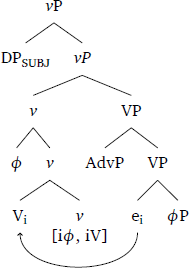
- (7)
- Phonological cliticisation (Cosentino)
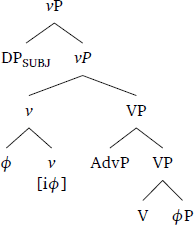
We now turn to enclisis with infinitives in Italian, Catalan, and Spanish. According to the traditional view, the infinitive targets a position above the clitic (Kayne 1991). This hypothesis has been supported by Schifano’s (2018) study on verb placement in Romance, as she shows that infinitives move higher in the abovementioned varieties. Since, in this context and in these languages, the verb and the clitic occupy different heads, we conclude that cliticisation is phonological (8), that is the clitic leans on the verb at Spell-Out (but not in the syntax). We follow the assumption that the HMC does not exist (see Roberts 2010: Chapter 5).
- (8)
One anonymous reviewer points out that interpolation, which we take as a useful theoretical tool for diagnosing phonological cliticisation, is typically not found in the context of enclisis. It is nevertheless possible in other varieties, as observed with finite verbs in Borgomanerese (Tortora 2010):
- (9)
- Borgomanerese (Tortora 2010: 138)
- I
- scl
- vangumma
- see
- già-nni
- already=1pl
- da
- of
- dü
- two
- agni
- years
- ‘We’ve already been seeing each other for two years’
Why does Borgomanerese allow interpolation with enclisis, whereas Italian infinitives do not, is challenging to account for if we assume that both contexts display phonological cliticisation (unless perhaps if we assume that clitics target a different projection in Borgomanerese, as proposed by Tortora 2010). The ungrammaticality of interpolation with enclisis in some languages has been raised by Mavrogiorgos (2013), who distinguishes several ways for grammars to derive proclisis and enclisis. Regarding the case under investigation here, Mavrogiorgos’ (2013) hypothesis is that a head c-commanding the cliticisation site contains (or may contain, as we understand it) syntactic features that require to be phonologically realised by a verbal host. Building on his view, we interpret the difference between Borgomanerese finite clauses (enclisis and interpolation) and Italian non-finite clauses (enclisis and compulsory verb-clitic adjacency) as residing in the absence of syntactic features in the verb in the former language. Further empirical investigation is needed to evaluate this claim, however it allows us to maintain the claim that enclisis is essentially a PF-phenomenon.
Both interpolation and enclisis share the characteristic that the clitic does not adjoin to its verb in the syntax, or in other words, the clitic maintains a certain syntactic autonomy by not forming a complex head with its verb. As such, enclisis involves structural proclisis on a functional head, but linear enclisis at Spell-Out. Put differently, since we take cliticisation to be left-adjunction to v, cliticisation (at the syntactic level) is always proclitic. What we see as proclisis and enclisis is a manifestation of linearisation at Spell-Out. The ‘autonomy’ between the clitic and its selecting verb is also found in the case of CC, as the clitic does not adjoin to the infinitive (although it does so with the higher verb, a matter we address in section 7). Consequently, we conclude that the ability of the clitic to ‘climb away’ from the infinitive into the main clause is facilitated by phonological cliticisation. We further explore this concept and apply it to our data in the remainder of the paper. Before doing so, we discuss our theoretical assumptions with regards to restructuring to frame our analysis.
3.2 Restructuring clauses
As we mentioned in the introduction, CC occurs when the domain of the upper verb (e.g. a modal or aspectual verb) and the domain of the infinitival verb are united, or form a unique domain (Rizzi 1982 et seq.). The architecture we assume for restructuring clauses is given in (10) and adapted from Roberts (2010: 84). It is monoclausal and clitics (φ-heads, cf. Dechaine & Wiltschko 2002) are generated in the complement of the infinitive before cliticising on the appropriate v-head at Spell-Out (Solà 2002; Mavrogiorgos 2010; Gallego 2016).9 The restructuring verb is the projection of a functional head, more precisely a v-head that does not select for internal and external arguments (Cinque 2001; 2004; Wurmbrand 2004; 2006; 2016; Roberts 2010).10 As such the main verb really looks like a light verb/auxiliary.
- (10)
Further, we adopt the view that cliticisation is an operation that values interpretation via Agree (Mavrogiorgos 2010; Roberts 2010). In restructuring clauses, the higher v-head bears a set of unvalued φ-features and acts as a probe for the clitic. Upon Agree, the clitic appears on the restructuring verb (11): this is CC.
- (11)
This approach accounts for the apparent ‘long movement’ of the clitic (i.e. from the lower to the upper domain) without the requirement that the clitic move ‘through’ an intermediate head (pace Kayne 1989; Martineau 1990). In systems where CC is obligatory, the higher v-head necessarily bears a set of unvalued φ-features that probes the clitic. Once the features of the higher v-head are interpreted, the clitic is realised as left-adjoined on the restructuring verb.
A system that does not allow CC is the mirror image of (11), as the higher v-head cannot probe the clitic. Upon Agree, the clitic is realised in the lower domain and remains there, as is normally found in Modern French (12).11
- (12)
Between the late 13th and the early 16th century, CC is found in 100% of all restructuring clauses in our corpus. This indicates that cliticisation was systematically as in (11). This obligatoriness is attested in other Romance languages during the same period (Pescarini 2021),12 and a handful of modern languages,13 therefore this proposal can easily be extended to the analysis of CC in other varieties.14
4 Shifts in French
Our corpus offers evidence for two shifts in the diachrony of French. First, CC transitioned from being obligatory to a stage where its percentage became variable. Because this shift is simultaneously observed in other Romance varieties, we propose that CC became optional in late Middle French in a similar fashion to Modern Italian. We identify a second shift in early Modern French, with the loss of CC and the rise of systematic proclisis on infinitives. In what follows, we illustrate the three stages and discuss their structural properties.
4.1 Stage 1: 12th–16th century
Our data show that clitics necessarily target the higher v-head in early French restructuring clauses, until the 16th century (Table 4). Based on our theoretical proposal, the higher v-head is associated with φ-features valued by the clitic.
Clitic climbing for Stage 1.
| Century | Clitic climbing |
| 12th | 93.3% |
| 13th | 98.8% |
| 14th | 100% |
| 15th | 100% |
| 16th | 96% |
- (13)
- a.
- (Etablissements et Coutumes, p.43. 13th c.)
- Bertrans
- B.nom
- ne le volt
- neg=3sg=wants
- randre
- render-inf
- ‘Bertran does not want to give it back’
- b.
This first stage is characterised by obligatory climbing: the clitic forms a complex head with the higher v, namely the restructuring predicate. This latter point is further supported by the absence of interpolation in this context (which we revisit in section 5.1) and the ability of the complex [clitic+verb] to move further upward to T.
4.2 Stage 2: late 16th to early 19th century
Shortly before the the 17th century, the higher v-head became optionally associated with φ-features, thus giving rise to the non-climbing option (as proposed by Roberts 2010 for Italian). In this new grammar, where the clitic can optionally be probed by the upper v-head, CC is optional – when the clitic does not climb, we find proclisis (Table 5). This is evidenced below with data from Bérault, a text which alternates between the two orderings: whilst the higher v-head can probe the clitic in (14), it does not have φ-features in (15).
Clitic climbing for Stage 2.
| Century | Clitic climbing |
| 16th | 96% |
| 17th | 71.1% |
| 18th | 55.9% |
- (14)
- (Bérault, p.5. 1614)
- il
- it
- se faut
- refl=be-necessary
- contenter
- content-inf
- d’imiter
- to-imitate-inf
- les
- the
- peintres
- painters
- ‘It is necessary to content oneself with imitating painters’
- (15)
- (Bérault, p.144. 1614)
- on
- one
- pourroit
- could
- bien
- well
- le faire
- 3sg=make-inf
- appeller
- call-inf
- ‘One could surely get him called’
Stage 2 is the result of a shift in the grammar that occurred across the Romance family. Most contemporary Romance varieties remained at stage 2, namely Italian, Catalan, Spanish, European Portuguese and Occitan – some of these varieties have enclisis instead of proclisis, yet we believe that this connects to infinitive placement rather than clitic placement, as argued by Kayne (1991), Roberts (2010) and Olivier (2022a; 2023).
4.3 Stage 3: early 19th century to present day
By the early 19th century, we do not find any instance of CC anymore (Table 6). We take this as evidence for a second shift in French, where the higher v-head entirely loses its ability to probe the clitic. From then on, proclisis on the infinitive is the only option.
Clitic climbing for Stage 3.
| Century | Clitic climbing |
| 19th | 0% |
- (16)
- a.
- (Pannier, p. 1. 1856)
- on
- one
- pouvait
- could
- la prendre
- 3sg=take-inf
- ‘One could take her’
- b.
This stage concludes the diachrony of clitic placement in restructuring clauses. In summary, throughout the last millennium, we observe that clitics have got closer to the verb that selects them. At one end of the evolution, clitics are systematically realised high on the structure (this is CC), whereas at the other end they are necessarily proclitic on the infinitive, in a low position.
4.4 Interim summary
Our investigation reframes the development of CC in French as a series of two shifts (Table 7). The shift from Stage 1 to Stage 2 is traditionally identified in the literature as marking the loss of CC (Iglesias 2015; Amatuzzi et al. 2020), but based on synchronous cross-linguistic evidence we argue that this shift has taken place uniformly across most Romance varieties. Based on data available for Stage 2, we have shown that both CC and proclisis are available in restructuring clauses, and that the percentages presented do not foresee the ultimate loss of CC. Unlike other Romance languages however, with the exception of Brazilian Portuguese (Davies 1996), French underwent a second shift in ca. 1800 which resulted in the loss of CC.
Obligatory, optionality and loss of clitic climbing.
| Stage | Century | Clitic climbing |
| 1 | 12th to 16th | Obligatory |
| 2 | Late 16th to early 19th | Optional |
| 3 | From 19th onwards | Absent |
If our interpretation of the data is on the right track, CC was optional in French similarly to what is found in Spanish, European Portuguese, Catalan and Italian, albeit for a shorter period.
5 The structure of restructuring clauses
In this section, we provide evidence for the type of structures involved in restructuring clauses. We first show that restructuring predicates are functional (cf. Cinque 2004), specifically v-heads. Second, we review evidence from V2 environments that show that clitics climb to v first, before the newly formed complex head moves to C. Finally, we interpret enclisis as evidence for the existence of a lower vP.
5.1 Evidence for the functional nature of restructuring verbs
We now turn to the nature of restructuring verbs, which we have taken to be functional following Cinque (2004) and Roberts (2010). In particular, we propose that clitic placement in this context can be used to diagnose the functional nature of restructuring verbs. Our rationale goes as follows: if restructuring verbs are v-heads, and that this same v-head can probe clitics, then interpolation (that is, the intervention of a phrase between the clitic and the verb) should not be possible.
Our dataset does not contain any occurrence of interpolation where CC has taken place, that is we did not find the order [φ+XP+v+Vinf]. Martineau (1990) cites one Old French example from Moignet (1976) where interpolation appears to occur despite CC (17). The intervening element is an adverb of intensification, which she claims is not a genuine case of interpolation but rather a clitic cluster, a hypothesis based on an analogous phenomenon in Romanian where the adverb mai ‘anymore’ is a clitic (see also Hinzelin 2010).
- (17)
- Middle French (Martineau 1990: 79)
- et
- and
- si
- if
- ne
- neg
- le par puet
- 3sg=really=can
- atainde
- reach-inf
- ‘and if he really cannot reach it’
- (18)
- Old French (Martineau 1990: 130)
- Qar
- because
- mot
- word
- li par somes
- 3sg=much=are
- mesfait
- wrong-make-PST.PTCP
- ‘Because we are not holding our promise to him’
In finite non-restructuring clauses, however, a few instances of interpolation are reported in the literature (see Moignet 1976 in particular), mainly for the Old French period.
- (19)
- Middle French (Martineau 1990: 79)
- au
- to-the
- jour
- day
- et
- and
- heure
- hour
- que
- that
- je
- I
- n’y pas
- neg=loc=neg
- commettray
- commit-fut
- ‘On the day and time that I will not commit to’
Whether these examples show interpolation is debated for several reasons: first, this construction is extremely rare and de Kok (1985) does not provide any example in her comprehensive documentation. Secondly, it is not clear whether the intervening element is a phrase since they have been analysed as clitics by Martineau (1990) and prefixes by Skårup (1975). Lastly, Hinzelin (2010) argues that apparent cases of interpolation in this context are scribal errors. Martineau (1990) attests rare instances in Middle French with the negation ne with finite lexical verbs, which she also attributes to scribal errors.
To conclude our observation, Old French is a language that never allows interpolation with restructuring verbs. If our analysis is on the right track, this is because interpolation is impossible with functional verbs as they are the locus of cliticisation – whereas clitic clusters with adverbial clitics should be possible. We interpret the absence of interpolation with finite lexical verbs as evidence for syntactic cliticisation, that is the clitic and the finite lexical verb necessarily form a complex head in Old French. In section 7, we will show that this was not the case with infinitives. Before doing so, we discuss clitic placement in V2 clauses in light of our claim that CC to restructuring predicates yields syntactic cliticisation.
5.2 Clitic climbing in V2 clauses
V2 clauses support the claim that the clitic incorporates with the restructuring verb early in the derivation. In Old French, the finite verb moves to the CP-layer once its features are valued (Adams 1987; 1989; Roberts 1993; Vance 1997; Labelle & Hirschbühler 2005; Labelle 2007; Ledgeway 2007; 2021; Wolfe 2016a; b; 2018; 2019; 2021a; b; Mathieu 2013; Holmberg 2015; Klævik-Pettersen 2018; 2019). Consider examples (20) to (22) where CC has taken place and the restructuring verb is in second position. Crucially, the inflected verb precedes the subject – the initial constituent is in brackets.
- (20)
- Old French (Établissements et Coutumes, p.80. 13th c.)
- [En
- in
- cest
- this
- cas]
- case
- ni doit
- neg=loc=must
- li
- the
- évesques
- bishop-nom
- nului
- noone
- recevoir
- receive-inf
- ‘In that case, the bishop must not receive anyone there’
- (21)
- Old French (Établissements et Coutumes, p.65. 13th c.)
- et
- and
- [lors]
- then
- se puet
- refl=can
- elle
- she
- marier
- marry-inf
- à
- to
- qui
- whom
- que
- that
- elle
- she
- voudra
- want-fut
- ‘and then she will marry whomever she wants to’
- (22)
- Middle French (Terrien, p.41. 1578)
- [Bie]
- well
- les peuuent-ils
- 3pl=can-they
- donner
- give-inf
- ‘They can give them well’
In these three examples, an XP is fronted in Spec,CP and both the clitic and the modal verb have moved to C. We argue that the clitic climbs to the modal first and they then move together, primarily because the clitic syntactically cliticises onto the modal verb before the two elements move as one head to C. The structure of (22) is given in (23).
- (23)
In light of the evidence introduced above, CC is necessarily a phenomenon of left-adjunction to a functional head that Spells Out as a modal, an aspectual or a motion verb. Crucially, once the clitic is in the domain of the higher functional verb, cliticisation is necessarily syntactic.
5.3 Evidence for a lower vP
Upon the assumption that restructuring verbs are functional heads merged in the vp-domain,15 Cinque (2004) argues that they lack argument structure and therefore do not select for an external argument (nor an internal one, but this is not relevant to us). Thus, the subject of the restructuring clause must be generated in the lower domain. On the cross-linguistic level, there is empirical evidence that (at least some) languages project an embedded vP in such clauses (see Wurmbrand 2016 on German and Austronesian). Our dataset allows us to support Cinque’s (2004) view, specifically the existence of a lower v-head in restructuring clauses.
Consider enclisis in examples (24) in Old French and the equivalent Italian example in (25). These are restructuring clauses without CC.
- (24)
- Old French (Établissements et Coutumes, p.18. 13th c.)
- il
- he
- ne
- neg
- puet
- can
- avoir la
- have-inf=3sg
- ‘He cannot have her’
- (25)
- Italian
- Non
- neg
- può
- can
- averla
- have-inf=3sg
- ‘He cannot have her’
Infinitives leave the vP domain in French until ca. 1300 (Olivier 2022a; 2023), a date which marks the shift from enclisis to proclisis in the grammar. Recall that we formally analyse cliticisation as φ-Agree with v. Following Kayne’s (1991) hypothesis, the infinitives in (24) and (25) target a Functional Projection higher than the clitic, but structurally lower than the restructuring predicate. In languages where the clitic can target the lower v and is enclitic (Old French, Italian, Spanish, Catalan), we propose that a light Functional Projection (FP)16 directly above the lower vP triggers V-movement (26).
- (26)
Consequently, although there are no clausal projections in restructuring environments, there is an embedded v-head which (i) assigns thematic role to the subject, and (ii) probes clitics.
6 Apparent counter-evidence
In this section, we report occurrences of CC in the presence of apparent embedded complementizers, and embedded Wh-clauses. We discuss these cases because they could be taken as prima facie evidence for an embedded CP and as such could be used to argue against our analysis of restructuring contingent upon a monoclausal structure.
6.1 Ad/de-complementizers
Romance infinitives can be introduced by a series of complementizers (sometimes called subordinators in the literature) which derive from Latin prepositions ad/de (Ledgeway 2012). These complementizers have been formally analysed as Fin-heads by Rizzi (1997). Under a monoclausal analysis, they should not be expected in restructuring clauses where CC is found, since we have seen that the structure lacks (at least) a CP-layer.17
We found 9 occurrences of CC over ad (7 in Old French, 2 in Middle French), and 3 occurrences with de (only in Middle French), spread from the 13th to the 16th century. Similar examples are found in Italian and Catalan.18 This construction is admittedly rare in our corpus, yet its presence requires further attention as it bears important consequences on any formal model of restructuring.
- (27)
- Old French (Ferri III, p. AD54_B_872_no_8 1258/08/00 1. Late 13th c.)
- nos
- we
- li somes
- 3sg=are
- tenu
- held
- a
- ad
- aidier
- help-inf
- ‘We have to help him out’
- (28)
- Middle French (Actes Royaux du Poitou, CCXVIII. Early 14th c.)
- Nous
- we
- le promettons
- 3sg=promise
- à
- ad
- parfaire
- perfect-inf
- le
- the
- plus
- most
- convenablement
- appropriately
- ‘We promise to perfect it in the most appropriate manner’
- (29)
- Middle French (Actes de la Chancellerie, JJ 172. Early 15th c.)
- […]
- le menacerent
- 3sg=threatened
- de
- de
- fere
- make-inf
- pendre,
- hang-inf
- tuer
- kill-inf
- ou
- or
- mectre
- put-inf
- a
- to
- mort
- death
- ‘Several Englishmen […], threatened to hang him, kill him or put him to death’
- (30)
- Middle French (Terrien, p.20. 1578)
- il
- he
- se tiedra
- ref=hold
- de
- de
- marier
- marry-inf
- ‘He will have to marry someone’
In sentences (27) to (30), the clitic is the syntactic object of the infinitive yet it cliticises on the finite verb, therefore these are clear cases of CC ‘over’ a complementizer. de Kok (1985: 224), Martineau (1990: 143) and Pearce (1990: 229) have reported similar examples in their corpora, and they also attest of the rarity of the construction. Martineau (1990) investigates two texts, from 1462 and 1505–1515, and finds 57 cases of CC with ad (for 107 infinitives introduced by ad) and 9 instances with de (for 509 infinitives introduced by de), which is higher than what we report. Although the construction is more frequent in her corpus, she also notices the scarcity of CC over de compared to ad. This difference in frequency can be explained through the diachrony of ad/de-complementizers: ad is found in high frequencies until the 16th century, before a shift took place and verbs started selecting de over ad (Martineau & Motapanyane 2000). Thus the rarity of de within the grammar naturally reduces chances to attest CC with it for the older periods.
Crucially the complementizers under scrutiny are always adjacent to the infinitive they introduce, and often in our corpus they are written as one word (e.g. arendre instead of a rendre). This adjacency is not found with genuine C-complementizers, which allow adverbs, shifted objects and auxiliaries to intervene (Martineau & Motapanyane 2000). Although there lacks a systematic empirical analysis of the distribution and behaviour of ad/de-complementizers in the diachrony of French,19 independent accounts have noted their affixal properties (Martineau & Motapanyane 2000), which may indicate that they trigger V-movement with infinitives (Kayne 1999; Olivier 2022a). Martineau (1990) also claims that such complementizers have an inflectional flavour, and she therefore analyses them as I-heads, similar to English to. We follow Kayne (1999) and Olivier (2022a) in assuming that ad/de-complementizers are located in a projection directly above vP.
Supporting evidence for the presence of a functional head hosting ad/de directly above vP is found in cases where the clitic does not climb but instead spells out enclisis: in (31) the ad-complementizer is in a Functional Projection above vP, where the clitic is realised. Given that these complementizers attract the infinitive outside v/VP, they necessarily pattern with enclisis. Note that enclisis was the standard ordering in non-restructuring environments until the early 14th century: according to Olivier (2022a; 2023), infinitives target the IP-layer (similarly to infinitives in modern Italian, Spanish and Catalan, see Schifano 2018). We expand on this claim in arguing that movement of the infinitive outside vP is also found in restructuring clauses where a Functional head hosting a complementizer is present.
- (31)
- Old French (Grand Coutumier, Seq 100. 1300)
- il
- he
- est
- is
- tenu
- held
- aamender la.
- ad=amend-inf=3sg
- ‘He has to amend it’
- (32)
Our proposal therefore is that ad/de-complementizers obligatorily trigger V-movement and are affixes (or perhaps clitics) on the infinitive, which explains why we never find proclisis in this context. This is supported by Martineau & Motapanyane (2000), who find evidence of two series of homophonous ad/de-complementizers until the 16th century, namely F-complementizers and C-complementizers. The former are found in restructuring clauses and are eventually reanalysed as C-complementizers, with which proclisis is found.20
To summarise these observations, we attest 4 different configurations in the diachrony of French (Table 8): in pre-1300 French, the clitic can Agree with either v-heads in restructuring clauses,21 and between the 14th and the 16th century the higher v-head always had unvalued φ-features in this environment.22 After the 16th century, clitics cannot Agree with the higher v-head in a presence of ad/de, which have been reanalysed as genuine C-complementizers: from this moment on, these clauses do not have a restructuring make-up anymore. Independent evidence for this comes from the fact that clitics keep climbing with modal verbs for two further centuries after being lost from clauses with ad/de.
Non-finite complementation and clitic placement.
| Structure | Period | φ-Agree | ad/de | Clitic placement | ||
| higher v | lower v | F-head | C-head | |||
| (33) | pre-1300 | ✔ | ✔ | CC | ||
| (34) | ✔ | ✔ | enclisis | |||
| (35) | ✔ | ✔ | enclisis | |||
| (33) | 14th–16th | ✔ | ✔ | CC | ||
| (35) | ✔ | ✔ | proclisis | |||
| (36) | post-16th | ✔ | ✔ | proclisis | ||
In (33) the clitic is probed by the higher v-head and the subordinator ad/de attracts the infinitive, resulting in CC:
- (33)
- a.
- (Terrien, p.20. 1578)
- il
- he
- se tiedra
- ref=hold
- de
- de
- marier
- marry-inf
- ‘He will have to marry someone’
- b.
In (34) the clitic is probed by the lower v-head and the subordinator ad/de attracts the infinitive, resulting in enclisis:
- (34)
- a.
- (Grand Coutumier, Seq 162. 1300)
- il
- he
- commencera
- start-fut
- maintenant
- now
- aaler sen
- ad=go-inf=refl=part
- ‘Now, he will start to go away’
- b.
Where ad/de is merged as a C-head, the environment is biclausal (35). As said earlier, the infinitive targets a high position in Old French and Spells Out enclisis. Unless an element intervenes between ad/de and the infinitive, it is virtually impossible to differentiate (34b) from (35) at Spell Out. Our corpus does not contain any example where an adverb or a shifted object appears, which should nonetheless have been possible (Martineau & Motapanyane 2000).
- (35)
From ca. 1300, infinitive movement out of v/VP is lost and the grammar has proclisis (see Olivier 2023 for a discussion). The only difference between (35) and (36b) is the lack of high V-movement in the latter.
- (36)
- a.
- (Terrien, p.16. 1578)
- mais
- but
- nous
- we
- attedros
- wait-fut
- a
- ad
- en parler
- part=speak-inf
- cy
- there
- apres.
- after
- ‘But we’ll wait and write about it thereafter’
- b.
In conclusion we argue that in clauses where CC is found over ad/de-complementizers, the latter occupy a light functional head directly above vP and trigger V-movement, which allows us to maintain a monoclausal analysis of restructuring.
6.2 Intervening Wh-phrases
Cases of CC over a moved Wh-phrase pose a second potential challenge to the monoclausal analysis of restructuring. Because Wh-elements are standardly assumed to move to the specifier of CP in Romance, Kayne (1989) argues that the construction in (37) is a strong indication of biclausality. His hypothesis takes CC to be head-movement through C, which Martineau (1990) applied to Middle French. The following two examples are drawn from our corpus.23
- (37)
- Old French (Ferri III, p. AD54_H_338_12_1297/00/00 1. Late 13th c.)
- je
- I
- ne
- neg
- le sauroie
- 3sg=know-cond
- a cui
- to whom
- rendre
- return-inf
- ‘I wouldn’t know whom to return it to’
- (38)
- Middle French (Actes de la Chancellerie, JJ 173. Early 15th c.)
- et
- and
- pour
- for
- ce
- this
- ne
- neg
- leur savoit
- 3sg=knew
- on
- one
- que
- what
- baillier
- give-inf
- ‘and for this, one did not know what to give them’
This construction has been discussed for Italian (39), and the literature contains an additional example for Catalan (40).
- (39)
- Italian (Rizzi 1982: 36)
- Su
- on
- questo
- this
- punto,
- point
- non
- neg
- ti saprei
- 2sg=know-cond
- che
- what
- dire
- tell-inf
- ‘On this point, I wouldn’t know what to tell you’
- (40)
- Catalan (Vos & Veselovská 1999: 1003)
- No
- neg
- et sabria
- 2sg=know-cond
- què
- what
- dir
- tell-inf
- ‘I wouldn’t know what to tell you’
We found only two examples in our corpus of CC over a Wh-phrase, but Martineau (1990: 110–111) reports more instances for Middle French. This construction is subject to several restrictions that have been reported for Italian (Cinque 2004; Cardinaletti 2014), and that Medieval French also shows: (a) it is only available with savoir/sapere ‘know’, similar Italian verbs like chiedersi and domandarsi ‘wonder’ yield ungrammatical results, (b) the main verb must be negated for the Wh-phrase to be preverbal, (c) the Wh-phrase must be adjacent to the infinitive, and (d) restrictions apply as to which Wh-phrase can be found in this construction: ‘when’ and ‘why’ are not accepted.
Based on this series of restrictions, Cardinaletti (2014) claims that this construction is not a case of Wh-movement analogous to what is found in questions, where such restrictions do not normally apply. Applying a cartographic method, she introduces evidence that the Wh-item follows all low adverbs, indicating clause-internal movement to a low position in the IP, directly above the VP. Furthermore, she claims that this position can only be filled by weak elements (in the sense of Cardinaletti & Starke 1999), which explains why only a subset of Wh-phrases are found in this construction: ‘when’ and ‘why’ are bisyllabic and strong in Italian (quando and perché). Lastly, she connects the necessary presence of the negation by the fact that weak Wh-phrases are indefinite, and as such she analyses them as polarity items that must be licenced by the sentential negation non – see Paradís (2019: 299–302) for an extensive discussion. Our data are similar to the ones she discusses, lending independent support for Cardinaletti’s (2014) perspective. Given that, as we previously saw, restructuring clauses do not project an embedded IP, the Wh-element in French must target a different position. Chomsky (2001) proposes that vP, being a weak phase, can serve as a landing site for XP-movement. Building on this claim, Nunes (2021) demonstrates that this applies to Wh-movement with ‘wonder’ in English.24 Thus, given that Wh-elements can move to the edge of v, we propose that examples (37) and (38) offer additional evidence for the existence of an embedded vP introducing the infinitive as discussed in section 5.3 above.25
7 Loss of clitic climbing in French
In this section, we will outline the changes in French and how they can be analysed as a shift between phonological and syntactic cliticisation.
7.1 Pre-19th century: phonological cliticisation
We attest the ultimate loss of CC in our corpus at the turn of the 19th century, which we argued is evidence that the higher v-head cannot probe the clitic anymore. Let us consider the diachrony of clitic placement in non-restructuring infinitival clauses in French. In clauses where the infinitive is not the complement of a functional verb, proclisis is the standard order since the 14th century (de Kok 1985; Olivier 2022b) – and before then enclisis is found. In this environment, the embedded v probes the clitic (41).
- (41)
- a.
- Modern French
- Alex
- Alex
- accepte
- accepts
- de
- to
- te voir
- 2sg=see-inf
- ‘Alex accepts to see you’
- b.
Let’s consider verb placement. French infinitives can optionally move above ‘low’ adverbs, for instance with souvent ‘often’ (Pollock 1989). We recast this observation as optional movement to v where the infinitive precedes the adverb (42).
- (42)
- a.
- (Ne pas)
- neg
- souvent
- often
- aller
- go-inf
- à
- to
- Paris.
- Paris
- ‘Not to go to Paris often’
- b.
- [IP ne [NegP pas [vP v [VP [souvent] aller [à Paris] ] ] ] ]
- (43)
- a.
- (Ne pas)
- neg
- aller
- go-inf
- souvent
- often
- à
- to
- Paris.
- Paris
- ‘Not to go to Paris often’
- b.
- [IP ne [NegP pas [vP aller [VP [souvent] aller [à Paris] ] ] ] ]
In addition, (42) shows that adverbs can potentially intervene between the clitic (in v) and the infinitive (in V). Unlike what we have seen earlier in finite clauses, proclisis was not necessarily adjacent on the infinitive in pre-19th century French, and adverbs are found to intervene (44). In addition, negation (45) and quantifiers (46) can also occur in this position (de Kok 1985: 337; Martineau 1990: 79; Hirschbühler & Labelle 1994).
- (44)
- Middle French (Actes de la Chancellerie d’Henri VI, JJ 173. Early 15th c.)
- et
- and
- adventure
- adventure
- de
- of
- y miserablement
- loc=miserably
- finer
- end-inf
- leurs
- their
- jours
- days
- ‘and that adventure to miserable end their days here’
- (45)
- Middle French (Pesnelle, p. 96. 1771)
- Pourquoi
- Why
- ne
- neg
- le pas
- 3sg=not
- anneler
- put-a-ring-inf
- ‘Why not put a ring in it?’
- (46)
- Middle French (Rouillé, 6v. 1539)
- Sans
- Without
- en rien
- part=nothing
- obmettre
- omit-inf
- ‘Without omitting anything about it’
As we saw earlier, interpolation of this kind has been documented across several Romance varieties (Pollock 2002; Miller & Monachesi 2003; Poletto & Pollock 2005; Ledgeway & Lombardi 2005), and we argued that it can serve as a diagnostic for phonological cliticisation: once the clitic is realised on v, it cliticises at Spell-Out on the nearest prosodic word. In other words, the clitic is ‘blind’ with regards to the element it cliticises on as long as it is one that can act as a prosodic host. Under this assumption, languages that have interpolation necessarily have phonological cliticisation (i.e. the clitic does not needs to ‘fuse’ with its prosodic host in the syntax). Contrarily, the mechanism is necessarily syntactic in languages where the clitic is obligatorily adjacent and proclitic on the verb – specifically because they form a complex head in narrow syntax. In such varieties (e.g. Modern French), the clitic attaches to the verb before Spell-Out and is akin to head-movement that is found in narrow syntax.
The interaction of optional Vinf-to-v movement and the possible presence of low adverbs generates four combinations that were synchronically available in Middle and Early Modern French (47). This optional movement further connects to the absence of a requirement of the clitic and the infinitive to form a complex head.
- (47)
- a.
- [IP [vP [iφ]v [VPVinf [φP ] ] ] ] ] VINF is in VP
- b.
- [IP [vP [iφ]v+Vinf [VP Vinf [φP ] ] ] ] ] VINF-to-v
- c.
- [IP [vP[iφ]v [VP adverb Vinf [φP ] ] ] ] ] VINF is in VP
- d.
- [IP [vP [iφ]v+Vinf [VP adverb Vinf [φP ] ] ] ] ] VINF-to-v
In (47a), the infinitive remains within the VP whereas it targets v in (47b). A difference is visible at Spell-Out once an adverb is introduced: interpolation is found when the infinitive remains low (47c). Out of the four combinations that were synchronically available in Middle French, three had the clitic adjacent to the infinitive (47a), (47b) and (47d). Furthermore, it is reported in the literature that interpolation is available with a subset of adverbs only (Hirschbühler & Labelle 1994; Pollock 2002; Miller & Monachesi 2003; Poletto & Pollock 2005; Ledgeway & Lombardi 2005), namely those that sit low in a cartographic hierarchy, and that it is not a frequent construction. We make the same observation, in our corpus we found only 13 examples scattered between the 15th and the 19th century.26
Interpolation with infinitives is arguably not common in the diachrony of French, but it is not a rare phenomenon either. We argue that it was available in the grammar exactly because cliticisation was phonological. Importantly, we demonstrated earlier that cliticisation was syntactic in finite contexts, therefore the mechanism of cliticisation must be domain-dependent: until the 19th century, finite and non-finite domains did not show the same type of cliticisation.
Turning to CC, we hinted towards the fact that the absence of interpolation with restructuring predicates indicated that cliticisation is syntactic in this context: we are now in a position to revisit this claim. We propose that CC was available as long as cliticisation was phonological in non-finite domains, which allowed the clitic not to form a complex head with its verb – put differently, clitics and infinitives were independent from each other, therefore the clitic could reach the upper domain as long as the higher v-head could probe it. Once the clitic climbed to the finite domain, and for the reasons outlined above, syntactic cliticisation yields. Precisely, our data show that interpolation and CC were lost at the same time, giving rise to systematically Vinf-adjacent proclisis.
7.2 Post-19th century: syntactic cliticisation
From the 19th century on, French shows systematically verb-adjacent proclisis, which we interpret as a new grammar showing syntactic cliticisation in non-finite domains.
We conclude that the loss of CC stems from the reanalysis of cliticisation from phonological to syntactic. We can hypothesise that what prompted this change to verb-adjacent proclisis is the fact that this order was overall more prominent in the grammar since it is always found with finite verbs, and it is the non-climbing option with infinitives (which as we have seen, is roughly 50% of the time in late Middle French). As such, (Middle) French differs from most Romance varieties, in that proclisis is frequent in all domains. Under the assumption that change spreads from main/finite to embedded/non-finite clauses (if we follow Lightfoot’s 1993 proposal that children are Degree-0 learners and utilise input mostly from main clauses, and therefore constructions that are found exclusively in embedded clauses are more susceptible to change and/or loss) syntactic cliticisation generalised from finite clauses to infinitives, where verb-adjacent proclisis was already frequent enough (in non-restructuring clauses, and as the non-climbing option).27 The diachrony of Brazilian Portuguese would be an ideal testing ground for this hypothesis, since it has lost CC and has proclisis on infinitives in some dialects (Davies 1996). It would be interesting to pursue this more systematic comparison between the two languages but this is something we have to leave open for future research.
8 Implications for other Romance languages
Our analysis naturally captures why CC remains present in most Romance varieties. We have shown earlier that the shift from obligatory to optional CC was a pan-Romance phenomenon that took place during the Renaissance period, and that French underwent a second shift that resulted in the loss of CC overall. Let us recall the facts about Italian, Spanish, and Catalan: in these languages, CC is optional and the infinitive targets a high functional projection (Roberts 2010; Schifano 2018). When the higher v probes the clitic, we find CC (48a), (49a), otherwise the clitic Agrees with the lower v and Spells Out enclisis (48b), (49b).
- (48)
- a.
- Italian
- Lo voglio
- 3sg=want-prs
- vedere
- see-inf
- ‘I want to see it’
- b.
- Voglio
- want-prs
- vederlo
- see-inf=3sg
- ‘I want to see it’
- (49)
- a.
- Catalan
- El vull
- 3sg=want-prs
- veure
- see-inf
- ‘I want to see it’
- b.
- Vull
- want-prs
- veure’l
- see-inf=3sg
- ‘I want to see it’
Looking at the diachrony of French, we argued that phonological cliticisation was present where the clitic and its infinitive do not target the same head in the derivation, and we have shown that this gives rise to three possible configurations: (i) interpolation with proclisis, (ii) CC, and (iii) enclisis. Let us consider the latter ordering in more detail, which we have argued in section 3.1 to be evidence of phonological cliticisation. The derivation of enclisis (48b), (49b) is given in (50).
- (50)
As usual, the clitic is realised on the lower v, yet the infinitive targets a higher position. Roberts (2010: 84) argues that infinitives can move over v because they “represent a neutralized category, not true verbs”. Crucially, the clitic is enclitic on the infinitive at Spell-Out (i.e. phonological cliticisation), although it is structurally proclitic on v (see Mavrogiorgos 2013 who reaches similar conclusions for Cypriot Greek and Bulgarian). We show that enclisis and CC both have in common the fact that the clitic enjoys some sort of independence from the infinitive, as in both cases, the clitic does not syntactically adjoin to the verb that selects it. Thus, in varieties that normally have enclisis in infinitival clauses, acquirers have sufficient cues to interpret cliticisation as a phonological phenomenon in non-finite domains, which in turn is a necessary condition for a grammar to have CC.28
Contrarily, we posit that varieties where proclisis is necessarily verb-adjacent (like Modern French) provide acquirers with a cue that cliticisation takes place early in the derivation, and that it is local. In the latter grammar, the mechanism acquired does not allow the clitic to climb to the higher v – and, perhaps consequently, the higher v does not have φ-features. Thus, the fundamental difference between Old French, Italian, Spanish and Catalan on the one hand, and Modern French on the other, is that the first group of languages have phonological cliticisation in non-finite domains, whereas the latter displays syntactic cliticization – and this is what sets Modern French apart from all other contemporaneous Romance varieties.
9 Clitic climbing and pro-drop
Before concluding, let us briefly address the relationship between the availability of CC and the null subject parameter. Old French, Middle French, Italian, Spanish, Occitan, European Portuguese and Catalan all have both CC and null subjects (Adams 1987; Vance 1989; 1997; Hirschbühler 1995; Balon & Larrivée 2016; Wolfe 2020), whilst Modern French lacks both. This has led previous literature to attempt to link both these phenomena, despite the fact that there is no apparent theoretical connection between CC and pro-drop. There have been attempts to capture this well-known empirical observation under the same parameter (Kayne 1989; Roberts 1994; Solà 2002), but in our view there is no direct correlation between the two. From a diachronic perspective, French transitioned into a non-null subject language at a much earlier time than it lost CC. Balon & Larrivée’s (2016) investigation is based on texts that we have included in our corpus and they situate the loss of pro-drop during the 13th century, whilst studies that find a later loss of null subjects analyse literary texts. Thus, there is at minimum a 400-year gap between the loss of null subjects and the loss of CC in the text type we analysed. We conclude that such a timespan does not support the hypothesis that the first change caused the second.
From a theoretical perspective, pro-drop has recently been argued to be available in languages where T is rich. Roberts (2014) builds on Alexiadou & Anagnostopoulou (1998) and Holmberg (2015), and argues that T contains referential D- and φ-features in null subject grammars, of which pro’s features are a subset. Following the definition of ‘defective goals’ introduced in Roberts (2010),29 Roberts (2014) claims that T[+D,+φ] can probe pro (a weak pronoun, along the lines of Cardinaletti & Starke’s 1999 analysis). In non-null subject grammars however, φ-features are subject to impoverishment and T cannot bear a D-feature, therefore pro fails to incorporate as it is not a defective goal anymore. In other words, Roberts (2014) tackles the notion of richness in proposing that T is rich when its φ-features are not impoverished, which gives rise to the presence of a D-feature and the incorporation of pro. In addition, Roberts (2014: 125) claims that C had a D-feature in Medieval French, therefore V2 structures were a necessary environment to license pro, and he argues that the reanalysis of increasing V3 orderings removed the environment conducive to pro-licensing. This hypothesis is also entertained by Wolfe (2021), according to whom Topic-heads license matrix and embedded null-subjects in the V2-grammar of Middle French. If these formal analyses of pro-drop are correct, there is no relationship with CC, which we claimed is available on two conditions: (i) the higher v-head must bear a set of unvalued φ-features, and (ii) the infinitival domain must have phonological cliticisation.
10 Conclusion
In this paper we reviewed the diachrony of CC in French and argued the following:
CC is a phenomenon analysed as φ-probing of a clitic to the main clause domain as a result of Agree. CC is found in classic restructuring environments and restructuring is a monoclausal structure, despite some apparent counter-evidence.
The diachrony in French involves a shift from a system with both syntactic and phonological cliticisation to one that only has the latter.
An important consequence of our analysis is that French never lost restructuring (pace Authier & Reed 2008) despite the lack of its most obvious expression, i.e. CC. The monoclausal structure remains, yet most transparency effects normally associated with restructuring are not available anymore. There is evidence that some transparency effects are still available in Modern French: Long Passivisation, which is traditionally analysed as a transparency effect (Cinque 2004; Wurmbrand 2016), is shown in sentences (51) and (52).
- (51)
- Modern French (Hobæk Haff & Lødrup 2016: 160)
- ili
- it
- est
- is
- fini
- finished
- d’être
- to=be.-inf
- tissé
- woven
- ei
- ‘it is done being woven’
- (52)
- Modern French (Hobæk Haff & Lødrup 2016: 161)
- Une
- a
- photoi
- picture
- est
- is
- souhaitée
- wished
- d’être
- to=be-inf
- postée
- posted
- ei
- x
- sur
- on
- l’événement
- the=event
- ‘It is wished that a picture will be posted on the event’
Examples (51) and (52) illustrate the object of the passivised embedded infinitival clause being promoted to the subject position of the main verb. The gender of the moved argument controls object agreement in both the main and the embedded past participle (masculine in (51), feminine in (52)).
Additionally, (optional) DP-movement to subject position is found when an aspectual verbs selects an infinitive with a reflexive clitic (53). This phenomenon, usually referred to as Long Object Movement and initially shown for Italian by Rizzi (1982), is taken as a bona fide transparency effect (we have already illustrated it with Old French data in (3)). Unlike in Italian however, the reflexive clitic does not climb to the upper verb.
- (53)
- Modern French
- De
- some
- nouveaux
- new
- logements
- housing
- sociauxi
- social
- commenceront
- begin-fut
- à
- to
- se construire
- refl=build-inf
- ei
- ‘One will start building new social housing’
Another piece of evidence concerns quantifiers that climb with restructuring predicates in Modern French (54), as discussed by Cinque (2002: 618).
- (54)
- Modern French
- J’ai
- 1sg=have
- touti
- everything
- osé
- dared
- lui dire
- 3sg=say-inf
- ei
- ‘I dared tell him everything’
In (54) the quantifier tout, associated with the embedded infinitive, appears in the domain of the main verb.
We analysed restructuring as the necessary environment for CC, and we showed that clitic placement (CC, enclisis, proclisis, interpolation) is further dependent on two parameters: verb placement and the mechanics of cliticisation. The cross-linguistic variation that we attest in this context in Romance stems from change on the micro-parametric level on v-heads (Roberts 2019), rather than changes in clausal architecture. Whilst we addressed why CC was lost, further research should investigate the loss of auxiliary switch and se-passives.
Notes
- CC is also observed outside Romance, see Tagalog (Wurmbrand 2013) and Kru languages (Haverkort 1990; Cinque 2004). [^]
- For each example taken from our corpus, we have indicated the date. Unless the exact year was possible to define, we added the century from which the example comes from. [^]
- Ibero-Romance is a notable exception to auxiliary switch, since these varieties systematically construct compound tenses with have. [^]
- Some of these texts have otherwise been studied, notably in relation to the diachrony of pro-drop (Balon & Larrivée 2016), and they have been the topic of a thematic issue for the journal Studia Linguistica Romanica (Goux 2022). [^]
- An anonymous reviewer asks whether there were formulaic parts in our corpus that should be taken into account in our analysis. Whilst the texts do have formulaic expressions, the latter did not include clitics and therefore did not bear any impact on our study. We note, however, that a few phrases with a clitic were used more than once, yet these are rare and were never counted more than three times in total. [^]
- Lois de Guillaume, Établissements et Coutumes, Grand Coutumier, Mortemer, Actes Normands, Lettres de rémission, Actes de la Chancellerie, Rouillé, Terrien, Bérault, Basnage, Merville, Pesnelle, Pannier. [^]
- We excluded from SCRIPTA all material written in Latin. We selected texts written between 1154 and 1294 and divided them in three groups. [^]
- An anonymous reviewer asks whether the loss of CC in the 18th century may correspond to a change in written (formal) language, which retains archaic features longer than speech, as outlined by Ayres-Bennett & Caron (2016) for French. Although we cannot be sure about the feature of 18th-century speech, the hypothesis that CC was lost in this context first is convincing, given that it is still found in highly formal and literary registers well into the 20th century, despite the fact that it is by then lost in colloquial oral language. [^]
- Restructuring clauses have also been analysed as biclausal (Kayne 1989; Martineau 1990; Paradís 2018; 2019). Kayne (1989) proposes that CC results from movement through C, which he uses to account for the ungrammaticality of complementizers in this context. [^]
- In Cinque’s (2004) proposal, which we adapt here, restructuring verbs are analysed as Mod/Asp-heads. [^]
- In languages where the clitic can optionally target the lower v and is enclitic (Italian, Spanish, Catalan), we propose that a light functional projection directly above the lower vP triggers V-movement. As Olivier (2022a) observes, this configuration is only found in varieties where the suffix <-r> is phonologically realised, therefore the FP must be the locus of the infinitival morphology. Until ca. 1300, the infinitival suffix was pronounced in French. From its loss on, there is no reason to assume that the FP remained (note that this loss originally concerned all verbs, not just <-er> verbs). [^]
- Optional CC is a fairly recent development in Romance and the empirical view we provide for Old and Middle French is mirrored in Old Portuguese (Davies 1996; de Andrade & Namiuti-Temponi 2016), Old Catalan (Fischer 2000), Old Spanish (Wanner 1982; Davies 1995), and Old Occitan (Bekowies & McLaughlin 2020). Quantitative studies for all these languages have shown that CC was obligatory during the medieval period, and according to Bekowies & McLaughlin (2020) it became optional between the 15th and the 17th century, depending on the language. [^]
- Modern languages that have obligatory CC in restructuring contexts include Sardinian (Mensching & Remberger 2016), Southern Italian Dialects (Ledgeway 2016), certain contexts in Romanian (Maiden 2016) or even Griko (Chatzikyriakidis 2010), a variety of Greek spoken in the south of Italy. [^]
- An anonymous reviewer asks why CC was never lost with perfective auxiliaries (have/be). First, auxiliaries and modals vary crosslinguistically, it is well-known that auxiliaries are somewhat stronger/richer. In Modern French for instance, infinitive auxiliaries can optionally move high (ne pas avoir vs. n’avoir pas), unlike modals (ne pas pouvoir vs. *ne pouvoir pas). Further, we anticipate the structural properties of the complement (infinitives in the case of restructuring, past participles in the case of compound tenses) to differ. Lastly, and from a more diachronic perspective, we can expect the loss of CC with modals but not with auxiliaries to have been accelerated by the pair that follows, which was available in earlier French (see Galet 1971 cited in Hirschbühler & Labelle 1994):
- (i)
- a.
- Je
- I
- le veux
- 3sg=want
- acheter.
- buy-inf
- ‘I want to buy it.’
These two sentences are phonetically identical. Given that proclisis on infinitives was available in the language (when subject or when introduced by a preposition), it may have been further generalised. This homophony never existed with auxiliaries, and whilst freestanding infinitives can select a clitic, past participles cannot. [^]- b.
- Je
- I
- le veux
- 3sg=want
- acheté.
- buy-PTCP
- ‘I want it bought.’
- In this paper, we follow Roberts’ (2010) assumption that restructuring verbs are merged as v-heads, rather than in the inflectional domain. An anonymous reviewer asks how we can exclude that restructuring predicates are merged in I-heads. If the higher predicate is merged in I without an upper v-head present, the clitic would remain in the lower domain, unless we postulate an ad-hoc escape mechanism for the clitic to move to I. It is unclear why the clitic would move to I at all, since we assume clitic movement to be probed by v. Therefore, in order for the clitic and the modal verb to form a complex head in narrow syntax, they must fuse onto v. [^]
- As Olivier (2022a) observes, this configuration is only found in varieties where the infinitival morphology -r is phonologically realised, therefore the FP must be the locus of the infinitival morphology. Until ca. 1300, the infinitival suffix was pronounced in French (Marchello-Nizia et al. 2020: 850–851). From its loss on, there is no reason to assume that the FP remained. [^]
- There is a longstanding debate in the literature with regards to the nature of such complementizers. Specifically, a number of authors argue that ad/de are genuine complementizers in restructuring clauses, and that therefore this environment must be biclausal (see Luján 1980, Kayne 1989: fn26, Manzini & Savoia 2005; Bok-Bennema 2010; Paradís 2018; 2019). [^]
- See Paradís (2018: 291) for Catalan. She proposes that these complementizers are defective C-heads, to account for their existence in restructuring environments. [^]
- It is worth noting that this observation holds for Romance in general. Finite complementation has been studied to a great extent across a high number of varieties (Rizzi 1997; Roussou 2010; Manzini 2014; Colasanti 2018; Colasanti & Silvestri 2019), whereas non-finite complementizers have been overlooked and are yet to be investigated in full. [^]
- Because CC over ad/de was lost before CC with modal verbs (i.e. selecting bare infinitives), we propose that Functional ad/de were reanalysed as genuine complementizers during the Middle French period, a conclusion independently reached by Martineau & Motapanyane (2000), notably on the grounds that the two series of ‘complementizers’ (i.e. the F-head and the C-head) were homophonous. If this is right, then monoclausal environments such as [Vfin à Vinf] where à is an F-head were reanalysed as a biclausal structure with à in C. An anonymous reviewer introduces further evidence for a general shift from monoclausality to biclausality: predicates like tenir ‘have to’ initially did not select any complementizer: être tenu Ø payer ‘have to pay’. We interpret this construction as monoclausal. The rise of overt complementizers increased towards the end of the Old French period (Martineau & Motapanyane 2000), therefore we propose that there were two stages of monoclausality, namely tenir payer > tenir de payer, followed by the reanalysis of de as a C-head, thus yielding biclausality. This does not imply, however, that genuine monoclausal sentences with a modal verb also became biclausal. [^]
- An anonymous reviewer observes that both CC and cliticisation on the infinitive were available in Old French. Cases where the clitic does not climb in Old French are extremely rare and, in our view, cannot be taken to be representative of the grammar. In languages where both options are available in total optionality (e.g. Spanish, Catalan, Italian, European Portuguese), the percentages of usage do not favour one or the other as much (see Davies 1995 for Spanish and de Andrade 2010 for European Portuguese). Regarding the few cases of enclisis in Old French restructuring clauses, although they are undeniably possible in the grammar, they are in minority and do not indicate a grammar with genuinely optional CC. [^]
- In non-restructuring clauses however, there is evidence that the ‘lower’ v-head can probe the clitic (Olivier 2022b). For reasons that would take us too far afield, we observe that clitics Spell Out on the highest v-head that can probe them. In restructuring clauses, this is the higher v-head, where in biclausal structures it is the v-head introducing the infinitive. [^]
- Following Cardinaletti (2014) we analyse a cui in (37) as a weak element. [^]
- According to Nunes (2021), the only way to establish an Agree relation between the complementizer and the Wh-element is through movement to Spec,vP. [^]
- We thank an anonymous reviewer for suggesting to explore whether vP could serve as an appropriate target for the moved Wh-element. We proposed earlier that a light functional projection was present between IP and vP in restructuring clauses to account for the presence of ad/de. The presence of Wh-phrases in the same context may be evidence of this FP being active here – we leave open the possibility that the Wh-phrase moves to Spec,vP or Spec,FP. [^]
- The instances of interpolation in our corpus include the following intervening elements: miserablement ‘miserably’, bien ‘well’, mieux ‘better’, rien ‘nothing’, point/pas ‘not’. [^]
- An anonymous reviewer asks how the generalisation of syntactic cliticisation to infinitives evidenced by the loss of interpolation connects to the earlier shift from enclisis to proclisis. We consider enclisis to necessarily be a case of phonological cliticisation, since the clitic (in v) and the verb (in IP) are realised in different domains. To summarise this latter point, we propose that the diachrony of cliticisation in French infinitival clauses is as follows: (i) phonological in Old French (evidenced with enclisis and CC); (ii) phonological until the late 19th century (evidenced with interpolation with proclisis and CC); (iii) syntactic in Modern French (evidenced with systematically adjacent proclisis). [^]
- According to our analysis, there is a connection between enclisis and CC. Nevertheless, although both orders depend on phonological cliticisation, it is theoretically possible for a grammar to have enclisis yet lack CC if the higher v-head cannot probe the clitic. [^]
- In Roberts (2010), a goal is defective when its features are a proper subset of its probe’s. In this proposal, a clitic’s φ-features are properly included in the probe v, and the content of the goal is exhausted upon Agree. [^]
Abbreviations
1 = first person, 2 = second person, 3 = third person, cc = clitic climbing, cond = conditional, fut = future, inf = infinitive, loc = locative clitic, neg = negation, nom = nominative, part = partitive clitic, prs = present, pst = past, ptcp = participle, refl = reflexive clitic, scl = subject clitic, sg = singular, V2 = verb second, V3 = verb third.
Acknowledgements
We wish to thank the three anonymous reviewers for their useful comments and suggestions.
Competing interests
The authors have no competing interests to declare.
References
Adams, Marianne. 1987. From Old French to the Theory of Pro-Drop. Natural Language and Linguistic Theory 5(1). 1–32. DOI: http://doi.org/10.1007/BF00161866
Adams, Marianne. 1989. Verb second effects in Medieval French. In Studies in Romance linguistics. selected papers from the seventeenth linguistic symposium on Romance languages, 1–31. DOI: http://doi.org/10.1075/cilt.60.02ada
Alexiadou, Artemis & Anagnostopoulou, Elena. 1998. Parametrizing AGR: Word order, V-movement and EPP-checking. Natural Language & Linguistic Theory 16. 491–539. DOI: http://doi.org/10.1023/A:1006090432389
Amatuzzi, Antonella & Ayres-Bennett, Wendy & Gerstenberg, Annette & Schosler, Lene & Skupien-Dekens, Carine. 2020. Changement linguistique et périodisation du franca̧is (pré)classique: Deux études de cas à partir des corpus du RCFC 30(3). 301–326. DOI: http://doi.org/10.1017/S0959269520000058
Authier, J. Marc & Reed, Lisa A. 2008. Against restructuring in modern French. University of Pennsylvania Working Papers in Linguistics 14(1). 2.
Ayres-Bennett, Wendy & Caron, Philippe. 2016. Periodization, translation, prescription and the emergence of Classical French. Transactions of the Philological Society 114(3). 339–390. DOI: http://doi.org/10.1111/1467-968X.12081
Balon, Laurent & Larrivée, Pierre. 2016. L’ancien français n’est déjà plus une langue à sujet nul–nouveau témoignage des textes légaux. Journal of French Language Studies 26(2). 221–237. DOI: http://doi.org/10.1017/S0959269514000222
Bauduin, Pierre. 2016. SCRIPTA, Database of medieval norman documents. http://www.unicaen.fr/scripta/acte/5574.
Bekowies, Zack & McLaughlin, Mairi. 2020. The loss of clitic climbing in French. In Wolfe, Sam & Maiden, Martin (eds.), Variation and change in gallo-Romance grammar, 138–157. Oxford: Oxford University Press. DOI: http://doi.org/10.1093/oso/9780198840176.003.0007
Bok-Bennema, Reineke. 2010. Restructuring verbs and the structure of Spanish clauses. In Structure preserved, 65–72. John Benjamins. DOI: http://doi.org/10.1075/la.164.08bok
Cardinaletti, Anna. 2014. On different types of clitic clusters. In De Cat, Cécile & Demuth, Katherine (eds.), The Bantu–Romance connection: A comparative investigation of verbal agreement, DPs, and information structure, 41–82. Amsterdam: John Benjamins Publishing Company. DOI: http://doi.org/10.1075/la.131.06car
Cardinaletti, Anna & Starke, Michal. 1999. The typology of structural deficiency: A case study of the three classes of pronouns. In van Riemsdijk, Henk (ed.), Clitics in the languages of Europe, 145–233. Berlin: De Gruyter Mouton. DOI: http://doi.org/10.1515/9783110804010.145
Chatzikyriakidis, Stergios. 2010. Obligatory Clitic Climbing in Grecia Salentina Greek: A dynamic account. In e-Proceedings of 4th modern Greek dialects and linguistic theory, 280–304.
Chomsky, Noam. 2001. Derivation by phase. In Kenstowicz, Michael (ed.), Ken Hale: A life in language, 1–51. MIT Press.
Cinque, Guglielmo. 2001. “Restructuring” and Functional Structure. Working Papers in Linguistics 11. 45–127.
Cinque, Guglielmo. 2002. A Note on “Restructuring” and Quantifier Climbing in French. Linguistic Inquiry 33(4). 617–636. DOI: http://doi.org/10.1162/002438902762731781
Cinque, Guglielmo. 2004. Restructuring and functional structure. In Belletti, Adriana (ed.), Structures and beyond: the cartography of syntactic structures, vol. 3, 132–191. Oxford University Press.
Colasanti, Valentina. 2018. Towards a microparameter C-hierarchy in Italo-Romance. In Romance Syntax. Comparative and diachronic perspectives, 191–226. Newcastle: Cambridge Scholars Publishing.
Colasanti, Valentina & Silvestri, Giuseppina. 2019. Matrix complementizers in Italo-Romance. Italian dialectology at the interfaces 251. 155. DOI: http://doi.org/10.1075/la.251.08col
Davies, Mark. 1995. Analyzing Syntactic Variation with Computer-Based Corpora: The Case of Modern Spanish Clitic Climbing. Hispania 78(2). 370–380. DOI: http://doi.org/10.2307/345438
Davies, Mark. 1996. A corpus-based approach to diachronic clitic climbing in Portuguese. Hispanic Journal 17(1). 93–111.
de Andrade, Aroldo Leal. 2010. The Application of Clitic Climbing in European Portuguese and the Role of Register. In Borgonovo, Claudia & Español-Echevarría, Manuel & Prévost, Philippe (eds.), Selected proceedings of the 12th hispanic linguistics symposium, 97–108. Somerville: Cascadilla Proceedings Project.
de Andrade, Aroldo Leal & Namiuti-Temponi, Cristiane. 2016. Gone without the verb: Clitic interpolation and clitic climbing in the history of Portuguese. Cadernos de Estudos Lingüísticos 58(2). 201–219. DOI: http://doi.org/10.20396/cel.v58i2.8647151
de Kok, Ans. 1985. La place du pronom personnel régime conjoint en français: une etude diachronique. Amsterdam: Rodopi. DOI: http://doi.org/10.1163/9789004649576
Dechaine, Rose-Marie & Wiltschko, Martina. 2002. Decomposing Pronouns. Linguistic Inquiry 33(3). 409–442. DOI: http://doi.org/10.1162/002438902760168554
Diez Del Corral Areta, Elena. 2011. Sobre el Modo, Manera, Suerte, Forma y Arte de conectar. Res Diachronicae Virtual 9. 33–50.
École des Chartes. 2011. Recueil des documents concernant le Poitou contenus dans les registres de la Chancellerie de France. http://corpus.enc.sorbonne.fr/.
Fischer, Susann. 2000. Obligatory Clitic Climbing in Old Catalan. Linguistics in Potsdam 9. 63–76.
Foulet, Lucien. 1919. Petite Syntaxe de l’Ancien Français. Paris: Librairie Ancienne Honoré Champion.
Galet, Yvette. 1971. L’Évolution de l’ordre des mots dans la phrase française de 1600 à 1700, la place du pronom personnel complément d’un infinitif régime. Presses universitaires de France.
Gallego, Ángel J. 2016. A phase-theoretic approach to cliticization in Romance. Studies in Hispanic and Lusophone Linguistics 9(1). 67–94. DOI: http://doi.org/10.1515/shll-2016-0003
Goux, Mathieu. 2022. Numéro thématique. Le temps long: l’évolution du français dans un corpus textuel calibré. le témoignage de la coutume de Normandie. Mathieu Goux (éd.). Studia Linguistica Romanica 8. 1–154.
Haverkort, Marco. 1990. Clitic climbing and barrierhood of VP. In Hutchison, John P. & Manfredi, Victor (eds.), Current approaches to African linguistics, vol. 7, 145–158. Dordrecht: Foris.
Hinzelin, Marc-Olivier. 2010. L’interpolation dans les langues romanes: aspects diachroniques. In XXVe CILPR Congrès International de Linguistique et de Philologie Romanes: Innsbruck, 3–8 Septembre 2007, 2–331. De Gruyter. DOI: http://doi.org/10.1515/9783110231922.2-331
Hirschbühler, Paul. 1995. Null Subjects in Verb-First Embedded Clauses in Philippe de Vigneulles. In Battye, Adrian & Roberts, Ian (eds.), Clause structure and language change, 257–292. Oxford: Oxford University Press.
Hirschbühler, Paul & Labelle, Marie. 1994. Changes in verb position in French negative infinitival clauses. Language Variation and Change 6(2). 149–178. DOI: http://doi.org/10.1017/S0954394500001629
Hobæk Haff, Marianne & Lødrup, Helge. 2016. Où en est le “passif long” en français? Syntaxe et sémantique 17(1). 153. DOI: http://doi.org/10.3917/ss.017.0153
Holmberg, Anders. 2015. Verb second. In Syntax – Theory and Analysis. an International Handbook of Contemporary Syntactic Research, 342–383. DOI: http://doi.org/10.1515/9783110377408.342
Iglesias, Olivier. 2015. Le placement des pronoms clitiques dans les complexes verbaux en français au XVIIe siècle: une approche idiolectale. In Travaux de linguistique, vol. 70, 91–120. De Boeck Supérieur. DOI: http://doi.org/10.3917/tl.070.0091
Kayne, Richard S. 1984. Connectedness and binary branching. Dordrecht: De Gruyter. DOI: http://doi.org/10.1515/9783111682228
Kayne, Richard S. 1989. Null Subjects and Clitic Climbing. In Jaeggli, Osvaldo & Safir, Kenneth (eds.), The null subject parameter, 239–261. Dordrecht: Reidel. DOI: http://doi.org/10.1007/978-94-009-2540-3_8
Kayne, Richard S. 1991. Romance clitics, verb movement and PRO. Linguistic Inquiry 22(4). 647–686.
Kayne, Richard S. 1999. Prepositional complementizers as attractors. Probus 11(1). 39–74. DOI: http://doi.org/10.1515/prbs.1999.11.1.39
Klævik-Pettersen, Espen. 2018. Inversion, V-to-C, and verb-second: An investigation into the syntax and word order of Old French and Late Latin: University of Oslo dissertation.
Klævik-Pettersen, Espen. 2019. What is Germanic and what is not about Old French V2. Linguistic Variation 19(1). 141–198. DOI: http://doi.org/10.1075/lv.00011.kla
Kytö, Merja. 2019. Register in historical linguistics. Register Studies 1(1). 136–167. DOI: http://doi.org/10.1075/rs.18011.kyt
Labelle, Marie. 2007. Clausal architecture in Early Old French. Lingua 117(1). 289–316. DOI: http://doi.org/10.1016/j.lingua.2006.01.004
Labelle, Marie & Hirschbühler, Paul. 2005. Changes in Clausal Organization and the Position of Clitics in Old French. In Grammaticalization and parametric variation, 60–71. Oxford University Press. DOI: http://doi.org/10.1093/acprof:oso/9780199272129.003.0004
Lalou, Elisabeth & Hélary, Xavier. 2017. Corpus philippicum – Actes des officiers et des agents royaux sous Philippe le Bel (1285–1314). http://ideal.irht.cnrs.fr/collections/show/1.
Larrivée, Pierre & Goux, Mathieu. 2021. Corpus ConDÉ. https://pdn-lingua.unicaen.fr/coutumiers/conde/accueil.html.
Le Feuvre, Claire. 2008. Le futur périphrastique dans les écorces de boulot de Novgorod. In Breuillard, Jean & Aslanoff, Serge (eds.), Construire le temps: études offertes à jeanpaul sémon. Paris: IES.
Ledgeway, Adam. 2007. Satisfying V2 in early Romance: Merge vs. Move. Journal of Linguistics 44(2). 437–470. DOI: http://doi.org/10.1017/S0022226708005173
Ledgeway, Adam. 2012. From Latin to Romance: Morphosyntactic typology and change. Oxford: Oxford University Press. DOI: http://doi.org/10.1093/acprof:oso/9780199584376.001.0001
Ledgeway, Adam. 2016. The dialects of southern Italy. In Ledgeway, Adam & Maiden, Martin (eds.), The Oxford guide to Romance languages, 246–269. Oxford: Oxford University Press. DOI: http://doi.org/10.1093/acprof:oso/9780199677108.003.0016
Ledgeway, Adam. 2021. V2 beyond borders. Journal of Historical Syntax 5(29). 1–65.
Ledgeway, Adam & Lombardi, Alessandra. 2005. Verb movement, adverbs and clitic positions in Romance. Probus 17(1). 79–113. DOI: http://doi.org/10.1515/prbs.2005.17.1.79
Lightfoot, David. 1993. Why UG needs a learning theory: triggering verb movement. In Historical linguistics, 190–214. Routledge.
Luján, María. 1980. Clitic promotion and mood in Spanish verbal complements. Linguistics. DOI: http://doi.org/10.1515/ling.1980.18.5-6.381
Maiden, Martin. 2016. Romanian, Istro-Romanian, Megleno-Romanian, and Aromanian. In Ledgeway, Adam & Maiden, Martin (eds.), The Oxford guide to Romance languages, 91–125. Oxford: Oxford University Press. DOI: http://doi.org/10.1093/acprof:oso/9780199677108.003.0008
Manzini, M. Rita. 2014. Grammatical categories: Strong and weak pronouns in Romance. Lingua 150(2009). 171–201. DOI: http://doi.org/10.1016/j.lingua.2014.07.001
Manzini, Maria Rita & Savoia, Leonardo Maria. 2005. I dialetti italiani e romanci: Morfosintassi generativa. In Morfosintassi generativa, Alessandria: Edizioni dell’Orso.
Marchello-Nizia, Christiane & Combettes, Bernard & Prévost, Sophie & Scheer, Tobias (eds.). 2020. Grande Grammaire Historique du Français (GGHF). De Gruyter. DOI: http://doi.org/10.1515/9783110348194
Martineau, France. 1990. La montée du clitique en moyen français: une étude de la syntaxe des constructions infinitives: University of Ottawa dissertation.
Martineau, France & Motapanyane, Virginia. 2000. Infinitive Subordinators and Verb Restructuring in French. In Dworkin, Steven & Wanner, Dieter (eds.), New approaches to old problems: Issues in Romance historical linguistics, 217. John Benjamins Publishing Company. DOI: http://doi.org/10.1075/cilt.210.18mar
Mathieu, Eric. 2013. The left-periphery in Old French. In Arteaga, Deborah L. (ed.), Research in old French: the state of the art (Studies in Natural Language and Linguistic Theory), 327–350. Dordrecht: Springer Netherlands. DOI: http://doi.org/10.1007/978-94-007-4768-5
Mavrogiorgos, Marios. 2010. Clitics in Greek: a minimalist account of proclisis and enclisis. Amsterdam/Philadelphia: John Benjamins Publishing Company. DOI: http://doi.org/10.1075/la.160
Mavrogiorgos, Marios. 2013. Enclisis at the syntax-PF interface. Challenging Clitics [Linguistik Aktuell/Linguistics Today] 206. 27–54. DOI: http://doi.org/10.1075/la.206.02mav
Mensching, Guido & Remberger, Eva-Maria. 2016. Sardinian. In Ledgeway, Adam & Maiden, Martin (eds.), The Oxford guide to Romance languages, 270–291. Oxford: Oxford University Press. DOI: http://doi.org/10.1093/acprof:oso/9780199677108.003.0017
Miller, Philip & Monachesi, Paola. 2003. Les pronoms clitiques dans les langues romanes. In Godard, Danièle (ed.), Les langues romanes: Problèmes de la phrase simple, 53–106. Paris: Editions du CNRS.
Moignet, Gérard. 1976. Grammaire de l’ancien français. Paris: Klincksieck 2nd edn.
Nunes, Jairo. 2021. On the locus and licensing of edge features. Glossa: a journal of general linguistics 6(1). DOI: http://doi.org/10.5334/gjgl.1113
Olivier, Marc. 2021. Language in Time: Assessing Medieval French Registers in a Quest for Accuracy in Historical Linguistics. French Studies Bulletin 42(159). 23–27. DOI: http://doi.org/10.1093/frebul/ktab012
Olivier, Marc. 2022a. A Corpus Study of Clitic Placement with Infinitives in the Diachrony of French: Ulster University dissertation. DOI: http://doi.org/10.13140/RG.2.2.19825.15203
Olivier, Marc. 2022b. Diachronie de la proclise et de l’enclise avec l’infinitif en français médiéval (12e–15e s.). Studia Linguistica Romanica 8. DOI: http://doi.org/10.25364/19.2022.8.2
Olivier, Marc. 2023. Clitic placement with infinitives in the diachrony of French: from enclisis to proclisis. https://lingbuzz.net/lingbuzz/007544.
Paradís, Anna. 2018. Variation in the scope of clitic climbing: Evidence from catalan dialectal data. Revue Roumaine de Linguistique 63(3). 281–295.
Paradís, Anna. 2019. L’ascens dels clítics: reestructuració i control: Universitat Autònoma Barcelona dissertation.
Pearce, Elizabeth. 1990. Parameters in Old French Syntax: infinitival complements. Dordrecht: Kluwer Academic Publishers. DOI: http://doi.org/10.1007/978-94-009-1884-9
Pescarini, Diego. 2021. Romance Object Clitics: Microvariation and Linguistic Change. Oxford: Oxford University Press. DOI: http://doi.org/10.1093/oso/9780198864387.001.0001
Poletto, Cecilia & Pollock, Jean-Yves. 2005. On wh-clitics, wh-doubling and apparent wh-in-situ in French and some North Eastern Italian dialects. Recherches linguistiques de Vincennes 16(33). 135–156. DOI: http://doi.org/10.4000/rlv.1317
Pollock, Jean-Yves. 1989. Verb Movement, Universal Grammar, and the Structure of IP. Linguistic Inquiry 20(3). 365–424.
Pollock, Jean-Yves. 2002. Three arguments for remnant IP movement in Romance. In Di Sciullo, Anna Maria (ed.), Asymmetry in grammar: syntax and semantics, 251–277. John Benjamins Publishing Company. DOI: http://doi.org/10.1075/la.57.12pol
Rizzi, Luigi. 1982. Issues in Italian Syntax. De Gruyter. DOI: http://doi.org/10.1515/9783110883718
Rizzi, Luigi. 1997. The Fine Structure of the Left Periphery. In Haegeman, Liliane (ed.), Elements of grammar: A hand- book of generative syntax, 281–337. Dordrecht: Kluwer. DOI: http://doi.org/10.1007/978-94-011-5420-8_7
Roberts, Ian. 1993. Verbs and Diachronic Syntax: a comparative history of English and French. Dordrecht: Kluwer Academic Publishers. DOI: http://doi.org/10.1007/978-94-011-2910-7
Roberts, Ian. 1994. Two Types of Head Movement in Romance. In Lightfoot, David & Hornstein, Norbert (eds.), Verb movement, 207–242. Cambridge: Cambridge University Press. DOI: http://doi.org/10.1017/CBO9780511627705.012
Roberts, Ian. 1997. Restructuring, Head Movement, and Locality. Linguistic Inquiry 28(3). 423–460.
Roberts, Ian. 2010. Agreement and Head Movement: Clitics, Incorporation, and Defective Goals. Cambridge: MIT Press. DOI: http://doi.org/10.7551/mitpress/9780262014304.001.0001
Roberts, Ian. 2014. Taraldsen’s Generalization and Language Change. In Functional structure from top to toe, 115–147. Oxford University Press. DOI: http://doi.org/10.1093/acprof:oso/9780199740390.003.0005
Roberts, Ian. 2019. Parameter Hierarchies & Universal Grammar. Oxford: Oxford University Press. DOI: http://doi.org/10.1093/oso/9780198804635.001.0001
Roussou, Anna. 2010. Selecting complementizers. Lingua 120(3). 582–603. DOI: http://doi.org/10.1016/j.lingua.2008.08.006
Schifano, Norma. 2018. Verb Movement in Romance: A Comparative Study. Oxford: Oxford University Press. DOI: http://doi.org/10.1093/oso/9780198804642.001.0001
Skårup, Povl. 1975. Les premières zones de la proposition en ancien français: essai de syntaxe de position. Akademisk forlag.
Solà, Jaume. 2002. Clitic climbing and null subject languages. Catalan Journal of Linguistics 1(1982). 225–255. DOI: http://doi.org/10.5565/rev/catjl.60
Stolk, Joanne Vera. 2015. Case variation in Greek papyri: retracing dative case syncretism in the language of the Greek documentary papyri and ostraca from Egypt (300 BCE–800 CE): University of Oslo dissertation.
Tortora, Christina. 2010. Domains of clitic placement in finite and non-finite clauses: Evidence from a Piedmontese dialect. In D’Alessandro, Roberta & Ledgeway, Adams & Roberts, Ian (eds.), Syntactic variation: The dialects of Italy, 135–149. Cambridge: Cambridge University Press.
Vance, Barbara S. 1989. The evolution of pro-drop in Medieval French. In Studies in Romance linguistics, 413–441. DOI: http://doi.org/10.1075/cilt.60.25van
Vance, Barbara S. 1997. Syntactic Change in Medieval French (Studies in Natural Language and Linguistic Theory). Dordrecht: Springer Netherlands. DOI: http://doi.org/10.1007/978-94-015-8843-0
Vos, Riet & Veselovská, Ludmila. 1999. Clitic questionnaire. In van Riemsdijk, Henk (ed.), Empirical approaches to language typology, 891–1009. Mouton de Gruyter.
Wanner, Dieter. 1982. A History of Spanish Clitic Movement. In Macaulay, Monica Ann (ed.), Proceedings of the eighth annual meeting of the berkeley linguistics, 135–147. Berkeley Linguistics Society.
Wolfe, Sam. 2016a. A comparative perspective on the evolution of Romance clausal structure. Diachronica 33(4). 461–502. DOI: http://doi.org/10.1075/dia.33.4.02wol
Wolfe, Sam. 2016b. On the left periphery of V2 languages: Evidence from Romance Fin and Force V2 systems. In Rivista di grammatica generativa: Selected papers from the 41st incontro di grammatica generativa, vol. 38, 287–310. https://lingbuzz.com/j/rgg/2016/wolfe_rivista_2016.pdf.
Wolfe, Sam. 2018. Syntactic variation in two sister languages: a study of word order in Old French and Old Occitan. In Panā Dindelegan, Gabriela & Dragomirescu, Adina & Nicula, Irina & Nicolae, Alexandru (eds.), Romance syntax. comparative and diachronic perspectives, chap. 5, 53–84. Newcastle: Cambridge Scholars.
Wolfe, Sam. 2019. Redefining the Typology of V2 Languages: The view from Medieval Romance and beyond. Linguistic Variation 19(1). 16–46. DOI: http://doi.org/10.1075/lv.15026.wol
Wolfe, Sam. 2020. Reconsidering variation and change in the Medieval French subject system. Glossa: a journal of general linguistics 5(1). 290–304. DOI: http://doi.org/10.5334/gjgl.942
Wolfe, Sam. 2021a. Parametric stability and word order change: the case of Middle French. Journal of Historical Linguistics 5. 1–44. DOI: http://doi.org/10.18148/hs/2021.v5i31.108
Wolfe, Sam. 2021b. Syntactic Change in French. Oxford: Oxford University Press. DOI: http://doi.org/10.1093/oso/9780198864318.001.0001
Wurmbrand, Susanne. 2001. Infinitives. Berlin, New York: Mouton de Gruyter.
Wurmbrand, Susi. 2004. Two types of restructuring – Lexical vs. functional. Lingua 114(8). 991–1014. DOI: http://doi.org/10.1016/S0024-3841(03)00102-5
Wurmbrand, Susi. 2006. Licensing case. Journal of Germanic Linguistics 18(3). 175–236. DOI: http://doi.org/10.1017/S1470542706000079
Wurmbrand, Susi. 2013. Tagalog infinitives: Consequences for the theory of phases, voice marking and extraction. http://ling.auf.net/lingbuzz/001898/current.pdf.
Wurmbrand, Susi. 2016. Complex Predicate Formation via Voice Incorporation. In Nash, Léa & Samvelian, Pollet (eds.), Approaches to complex predicates, 248–290. Leiden: Brill. DOI: http://doi.org/10.1163/9789004307094

